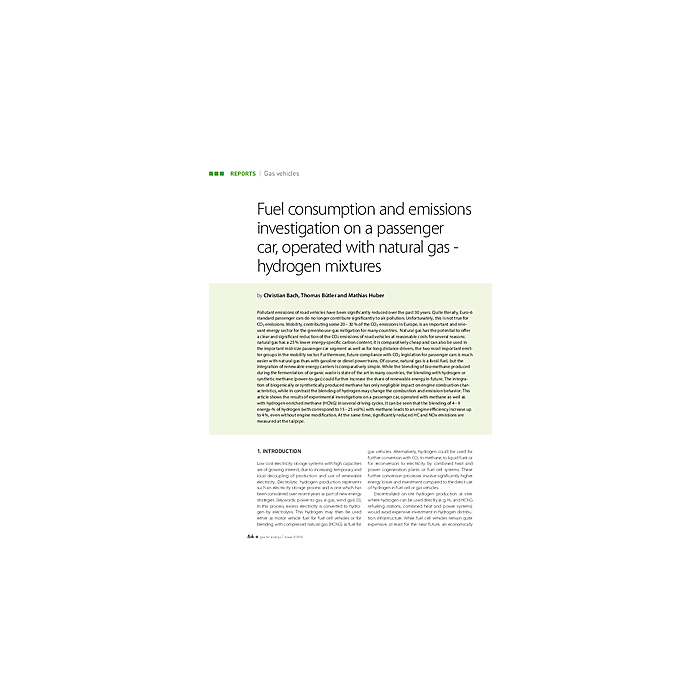Fuel consumption and emissions investigation on a passenger car, operated with natural gas - hydrogen mixtures
4,90 €
Auf Lager
Artikelnummer
00258_2015_02_09
Pollutant emissions of road vehicles have been significantly reduced over the past 30 years. Quite literally, Euro-6 standard passenger cars do no longer contribute significantly to air pollution. Unfortunately, this is not true for CO2 emissions. Mobility, contributing some 20 – 30 % of the CO2 emissions in Europe, is an important and relevant energy sector for the greenhouse-gas mitigation for many countries. Natural gas has the potential to offer a clear and significant reduction of the CO2 emissions of road vehicles at reasonable costs for several reasons: natural gas has a 25 % lower energy-specific carbon content, it is comparatively cheap and can also be used in the important mid-size passenger car segment as well as for long distance drivers, the two most important emitter groups in the mobility sector. Furthermore, future compliance with CO2 legislation for passenger cars is much easier with natural gas than with gasoline or diesel powertrains. Of course, natural gas is a fossil fuel, but the integration of renewable energy carriers is comparatively simple. While the blending of bio-methane produced during the fermentation of organic waste is state of the art in many countries, the blending with hydrogen or synthetic methane (power-to-gas) could further increase the share of renewable energy in future. The integration of biogenically or synthetically produced methane has only negligible impact on engine combustion characteristics, while in contrast the blending of hydrogen may change the combustion and emission behavior. This article shows the results of experimental investigations on a passenger car, operated with methane as well as with hydrogen enriched methane (HCNG) in several driving cycles. It can be seen that the blending of 4 – 9 energy-% of hydrogen (with correspond to 15 – 25 vol %) with methane leads to an engine efficiency increase up to 4 %, even without engine modification. At the same time, significantly reduced HC and NOx emissions are measured at the tailpipe.
| Autoren | Christian Bach / Thomas Bütler / Mathias Huber |
|---|---|
| Erscheinungsdatum | 01.02.2015 |
| Format | |
| Zeitschrift | gas for energy - Ausgabe 02 2015 |
| Verlag | DIV Deutscher Industrieverlag GmbH |
| Sprache | English |
| Titel | Fuel consumption and emissions investigation on a passenger car, operated with natural gas - hydrogen mixtures |
| Beschreibung | Pollutant emissions of road vehicles have been significantly reduced over the past 30 years. Quite literally, Euro-6 standard passenger cars do no longer contribute significantly to air pollution. Unfortunately, this is not true for CO2 emissions. Mobility, contributing some 20 – 30 % of the CO2 emissions in Europe, is an important and relevant energy sector for the greenhouse-gas mitigation for many countries. Natural gas has the potential to offer a clear and significant reduction of the CO2 emissions of road vehicles at reasonable costs for several reasons: natural gas has a 25 % lower energy-specific carbon content, it is comparatively cheap and can also be used in the important mid-size passenger car segment as well as for long distance drivers, the two most important emitter groups in the mobility sector. Furthermore, future compliance with CO2 legislation for passenger cars is much easier with natural gas than with gasoline or diesel powertrains. Of course, natural gas is a fossil fuel, but the integration of renewable energy carriers is comparatively simple. While the blending of bio-methane produced during the fermentation of organic waste is state of the art in many countries, the blending with hydrogen or synthetic methane (power-to-gas) could further increase the share of renewable energy in future. The integration of biogenically or synthetically produced methane has only negligible impact on engine combustion characteristics, while in contrast the blending of hydrogen may change the combustion and emission behavior. This article shows the results of experimental investigations on a passenger car, operated with methane as well as with hydrogen enriched methane (HCNG) in several driving cycles. It can be seen that the blending of 4 – 9 energy-% of hydrogen (with correspond to 15 – 25 vol %) with methane leads to an engine efficiency increase up to 4 %, even without engine modification. At the same time, significantly reduced HC and NOx emissions are measured at the tailpipe. |
Eigene Bewertung schreiben


